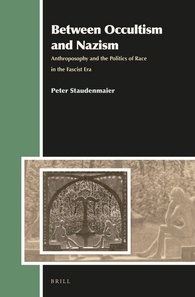Single News
A study of anthroposophy in the fascist era
The much-debated study by the US historian Professor Peter Staudenmaier about anthroposophy in fascist Germany and Italy has now been published in the Netherlands. Staudenmaier, who obtained his doctorate with this study at Cornell University/NY and who is often presented as a vehement critic of anthroposophy, now teaches at Marquette University Milwaukee.
Staudenmaier‘s book is an updated, greatly revised and abridged version of his dissertation. Alongside a densely-packed analysis of anthroposophical sources, this volume also offers an impressively comprehensive documentation and discussion of the relevant secondary literature on all the topics he deals with. Unfortunately Staudenmaier has failed to take account of a number of anthroposophical primary sources: the published diaries of Albert Steffen or the letters of Rudolf Steiner’s close collaborator Ita Wegman, writes Ansgar Martins who reviewed the book for NNA.
LEIDEN (NNA) – Between Occultism and Nazism: Anthroposophy and the Politics of Race in the Facist Era is the title of the book and it might at first sight give a misleading impression: not a few commentators have drawn the conclusion from it that Staudenmaier presents anthroposophy as paving the way for National Socialism, indeed as being similar in nature. But Staudenmaier warns repeatedly against such false conclusions. He rejects the stylisation of National Socialism into an “occult” movement as much as the assumption that esotericism and fascism were inexplicable, demonic eruptions of irrationality in contrast to enlightened modernism.
Rather, both of them have their origin in precisely such modernism, reactions to a society experienced as decadent and “materialistic”. The broad horizon of spiritual, messianically apocalyptic longings and anti-Semitic trends which came to appearance in Europe after 1900 could not be reduced to an “occult” milieu or the accusation of “irrationality”. With reference to the German sociologists and philosophers Theodor W. Adorno and Max Horkheimer, Staudenmaier’s starting point is a theory of the inherent contradictions of modernism with the resulting social problems.
Esotericism and society
Staudenmaier points out that it was hardly possible in the Weimar Republic not to have heard of Rudolf Steiner. It was not esotericism as a peripheral social phenomena, Staudenmaier says, but its broad base in the early twentieth century which had created the condition for fascist organisations and individuals to concern themselves with esoteric streams. The Lebensreform (“life reform”) movement and apocalypticism, national messianism and the longing for salvation had, for example, been topics which anthroposophists and other esotericists had shared with nationalistically inclined groups, Staudenmaier argues.
Themes had been prevalent in esoteric, nationalistic and Lebensreform writings of those years which could still be found in some anthroposophical publications to the present day. Staudenmaier quotes conspiracy theories about occult lodges, analyses of America’s thirst for power, resentment of the democratic state based on the rule of law and materialistic science as examples, tendencies which in these publications were opposed by the deeper perspective arising from “Central Europe”.
Personal overlaps
Finally, Staudenmaier presents not just an ideological but also a personal overlap between anthroposophy and National Socialism in the Nazi period, such as for example among anthroposophical doctors and farmers who were active in National Socialist back-to-nature associations and wrote for their publications. The fact that ecological agriculture and alternative medicine also aroused interest among leading members of the Nazi regime – the most well-known among them being Rudolf Hess – had to be seen against this background.
Hess, for example, also held a protective hand over the Waldorf school in Dresden which was not closed – as all the other schools had been – until 1941 after his flight to Scotland. Staudenmaier offers a great deal of material on this overlap. Accordingly there were anthroposophists who were enthusiasts for “German renewal” and members of the SS and the Nazi Party; individuals such as Georg Halbe or Hans Merkel enjoyed meteoric careers in the NS state.
On the other hand, Staudenmaier does not seek to deny the paranoid hate which parts of the Nazi elite fomented against any form of esotericism: one chapter deals with the Nazi “campaign against esoteric teachings” in 1941. The historian conceals neither Steiner’s universalistic and individualistic ambitions nor the fact that some of his pupils were declared opponents of the Nazi regime.
But that the members of the executive council of the Anthroposophical Society, Ita Wegman and Elisabeth Vreede, as well as many of their supporters rejected Hitler and did their best to help anthroposophists escape abroad remains unmentioned by Staudenmaier. The rejection of National Socialism by the executive council of the German Anthroposophical Society in 1933 also remains without mention. The only thing described is the rapid change of course which occurred a short while later (1934) under Hermann Poppelbaum.
Yet that these latter aspects do not form the focus of the study cannot really be held against Staudenmaier since the stated aim of his research is the connection between anthroposophy and National Socialism.
Anthroposophy in fascist Italy
There are still great gaps in the research on this subject, so Staudenmaier’s first comprehensive account of anthroposophy in fascist Italy deserves praise. Here there were clearly not just people among the anthroposophists who were supporters of anti-Semitic policies, Massimo Scaligero for example, but also those who were directly involved in planning and implementing the persecution of the Jews, such as Ettore Martinoli.
In contrast to Uwe Werner’s book Anthroposophen in der Zeit des Nationalsozialismus (Anthroposophists in the time of National Socialism) (1999), with its emphasis on historic events, Staudenmaier focuses in his study on the points of contact between anthroposophy and National Socialism. Anyone who wishes to obtain a thorough understanding of the history of anthroposophy in central Europe in the twentieth century cannot ignore the depressing documentation which has been assembled by Staudenmaier.
Limitations
There is, however, one respect in which the conclusiveness of this study is limited. Staudenmaier emphasises in the foreword to his work (p. 19) that he did not take account of “internal anthroposophical disputes”.
He is probably referring here above all to the split in the Anthroposophical Society after Rudolf Steiner’s death into groups loyal to Dornach and supporters of Wegman and Vreede. This perspective means that many leading anthroposophists of those years are not mentioned at all by Staudenmaier or only peripherally.
Ida Oberman showed in her 2008 study on the history of the Wadorf school movement (The Waldorf Movement in Education, Lewiston 2008, 72-171) that the fate of the Waldorf schools in the Nazi period cannot be understood without taking account of the profound split in the anthroposophical movement during these years. That is all the more true of the history of the Anthroposophical Society.
Staudenmaier’s account of Steiner’s theory of race is too vague, being only partly correct when he describes it as contradictory. The aspect of the way that Steiner’s undoubtedly incisive models of national psychology and theory of race underwent transformation among his supporters also remains blurred. Although Staudenmaier shows with a wealth of evidence how in this context there was an adaptation of nationalistic and esoteric as well as mainstream theories of race, his work here seems more like a broadly based discourse analysis and not a precise analysis of the conrete ideas of specific anthroposophical authors.
Staudenmaier often loses sight of the many different ways in which Steiner’s relevant theorems continued to be developed by his pupils. But that is not really to speak against this study but rather in favour of the further exploration of the field which it has opened up.
END/nna/ams
Peter Staudenmaier: Between Occultism and Nazism. Anthroposophy and the Politics of Race in the Fascist Era [ARIES-Book Series: Texts and Studies in Western Esotericism, Vol. 17], Leiden (Brill) 2014.
Item: 141005-04EN Date: 5 October 2014
Copyright 2014 News Network Anthroposophy Limited. All rights reserved.

